
What are the top priorities for the Biden administration? Combating the COVID-19 crisis, improving livelihoods and setting the American ship on the right track.
By Jane Sarasohn-Kahn, MA, MHSA
On January 20, 2021, Joseph R. Biden was installed as the 46th president of the United States. On that same day, the United States saw the greatest number of deaths caused by the coronavirus pandemic since the virus first emerged in the states in early 2020.
Those 4,440 joined the 400,000-some memorialized the night before as (then) President-elect Biden lit up 400 lights lining the Lincoln Memorial poolside, reminding Americans that we are still in the winter of the public health crisis.
As Biden sat for the first time at the Resolute Desk in the White House Oval Office, just a couple of hours into his new role, he signed executive orders that addressed some of the most pressing challenges he will immediately face in his new job.
Below, I’ve highlighted some of Biden’s top priorities since taking office last week.
The First Priority: COVID-19
It’s clear from the messaging coming out of his communications team, and staff appointments announced in the days leading up to the inauguration, that the top priority of the Biden administration will be the pandemic—with executive orders and a rescue plan meant to bolster lives and livelihoods through and beyond the pandemic.
Among the executive orders that Biden signed on the first two days of his presidency were many addressing some aspect of the pandemic and its impacts on citizens and the economy.

A National Call to Action: War on COVID-19 and Initiating the Defense Production Act
In calling out “wartime” on the coronavirus reminding the nation of over 400,000 lives lost—more than the entire World War II death toll—Biden nationalized the effort around personal protective equipment (PPE), such as N95 masks, vaccine supply and the vaccination process, and ramped up testing with machines and rapid test kits, with more detailed plans outlined in the National Strategy for the COVID-19 Response and Pandemic Preparedness. The plan has seven key elements:
- To restore trust with the American people
- To mount a safe comprehensive vaccination program
- To mitigate spread of the virus through expanding masking, testing, treatment, data, and workforce and public health standards
- To expand emergency relief and exercise the Defense Production Act
- To safely reopen schools, business and travel
- To protect those most at-risk and advance equity
- To restore U.S. global leadership and better prepare in advance for future pandemics
Masking Up
The photo of Biden signing the executive orders on his first day in office may be the first picture of a U.S. president wearing a face covering seated at the Resolute Desk.
President Biden issued the Executive Order on Protecting the Federal Workforce and Requiring Mask-Wearing | The White House. The “100 Days Masking Challenge,” as the order has been popularly dubbed, requires federal employees and government contractors to wear masks and distance in federal buildings and lands such as national parks, post offices, planes and Veterans Affairs facilities. Section 3 of this order also discusses “encouraging masking” around the U.S. via the secretary of Health and Human Services (HHS) and director of the Centers for Disease Control and Prevention (CDC), coordinating with governmental organizations along with business, unions, academia and other community leaders.
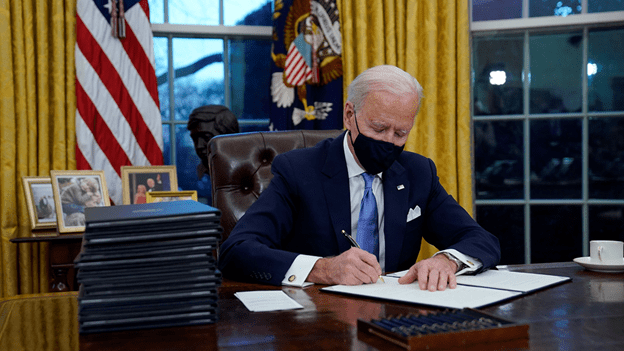
Addressing Health Equity and Social Determinants
The coronavirus has shed a somber and sobering light on health disparities in the U.S., with people of color at least 2.6 times more likely to die from complications of COVID-19 than white people. On his first day in office, Biden signed the Executive Order On Advancing Racial Equity and Support for Underserved Communities Through the Federal Government | The White House.

By signing this order, the Biden administration clearly articulated a commitment to confronting and dealing with health justice, creating a COVID-19 Health Equity Task Force to inform health policy and specifically expand testing, treatment and vaccination in communities at risk of falling through the healthcare safety net.
Weaving together a few of the executive orders and between the lines therein, we can see that Biden is taking a “whole of government” initiative to deal with racial equity and social justice—one of the crises facing the nation coming out of 2020.
“Equal opportunity is the bedrock of American democracy, and our diversity is one of our country’s greatest strengths. But for too many, the American Dream remains out of reach. Entrenched disparities in our laws and public policies, and in our public and private institutions, have often denied that equal opportunity to individuals and communities. Our country faces converging economic, health, and climate crises that have exposed and exacerbated inequities, while a historic movement for justice has highlighted the unbearable human costs of systemic racism,” the order says.
The tasks outlined here would go well beyond medical care, compelling every federal agency to review the “state of equity” in its portfolio and to develop action plans to reduce barriers in public policies that reduce all peoples’ opportunities.
Rejoining the World
On the second day of the new administration, Dr. Anthony Fauci met (virtually) with the Executive Board of the World Health Organization (WHO) as the U.S. Head of Delegation. In doing so, Dr. Fauci, who was named chief medical advisor to Biden, followed his executive order rejoining the WHO as directed in the Executive Order on Organizing and Mobilizing the United States Government to Provide a Unified and Effective Response to Combat COVID-19 and to Provide United States Leadership on Global Health and Security | The White House.
The fine print in Fauci’s remarks to WHO, embodied in this directive, addresses U.S. membership in WHO, making good on the U.S. financial commitments to the organization, participation in technical collaboration, advancing global health for all people, rejoining COVAX (the global accelerator for a COVID-19 vaccine and therapeutics), and supporting women’s and girls’ health.
Protecting Housing During the Pandemic
The pandemic spawned an uptick in housing insecurity across the U.S., felt especially among low- and moderate-income householders. As part of the immediate pandemic response, Biden requested that the CDC extend the housing eviction moratorium until at least March 31, 2021, explained in a statement from newly appointed CDC Director Dr. Rochelle Walensky.
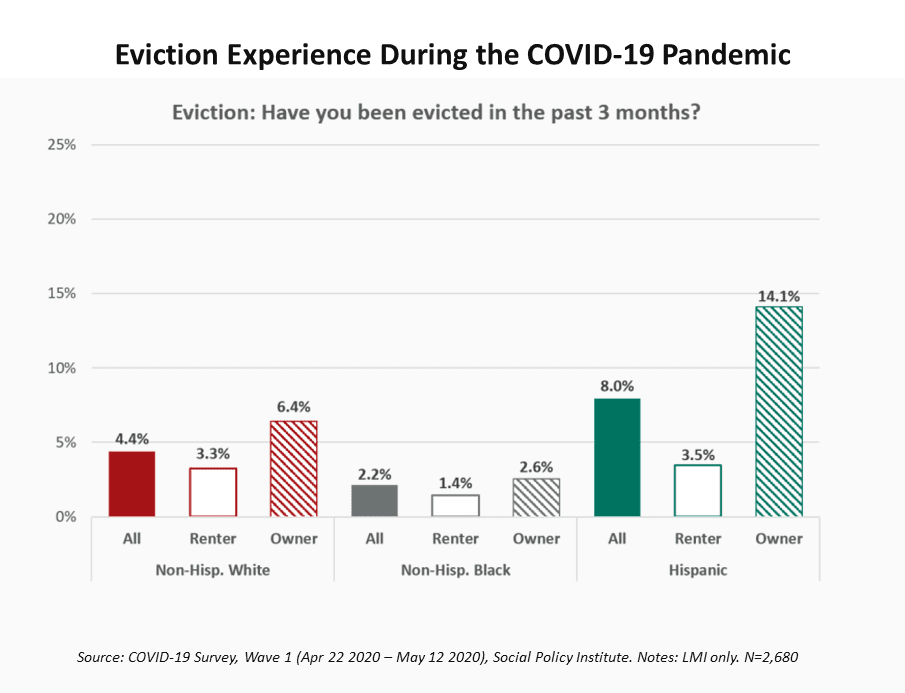
Housing is a key social determinant of health; the COVID-19 pandemic and accompanying economic downturn has hit lower-income people harder than people with a higher socioeconomic status. This action is a short-term stopgap; we can expect further action on this as the late March deadline approaches. Housing advocates have argued that the moratorium on evictions has not addressed the underlying home insecurity some people have experienced in the wake of COVID-19 in early 2020. [Note: Housing security has gained growing attention as a social determinant of health among healthcare stakeholders such as hospitals systems and health plans].
Seeking $1.9 Trillion
The Biden American Rescue Plan budget’s line items cover a broad portfolio of investments to combat COVID-19’s clinical, economic and social impacts. Some of the funds would be allocated to bolstering subsidies for Americans looking to sign up for Affordable Care Act health insurance plans, as well as providing funds for ailing hospitals whose finances have been strapped by COVID-19 care (earmarked in a Disaster Relief Fund), vaccination programs, testing, and a new pandemic-focused job corps to pay for 100,000 public health workers. There would be funds to support the safe reopening of schools, which could boost parents’ ability to return to work and businesses’ ability to bring staff back to the workplace. In addition, there are hundreds of billions of dollars for relief for small businesses and state and local governments, employment provisions to boost the minimum wage to $15 an hour, a child tax credit, and other items targeting caregivers.
The fine print in this plan addresses equity and the vision of “building back better” for prosperity addressing all citizens seeking to rebuild the U.S. economy in a more equitable way as defined by the Biden administration. This speaks to the so-called “K-Recovery” theory of wealthier Americans faring financially better in the pandemic than people earning lower incomes (the lower leg of the “K”). The graphic here illustrates how the U.S. Chamber of Commerce views the concept through their business stakeholder lens, showing the recession-prone industries of hospitality, travel and food services on the decline with the concomitant rise of retail, tech and software during the pandemic.
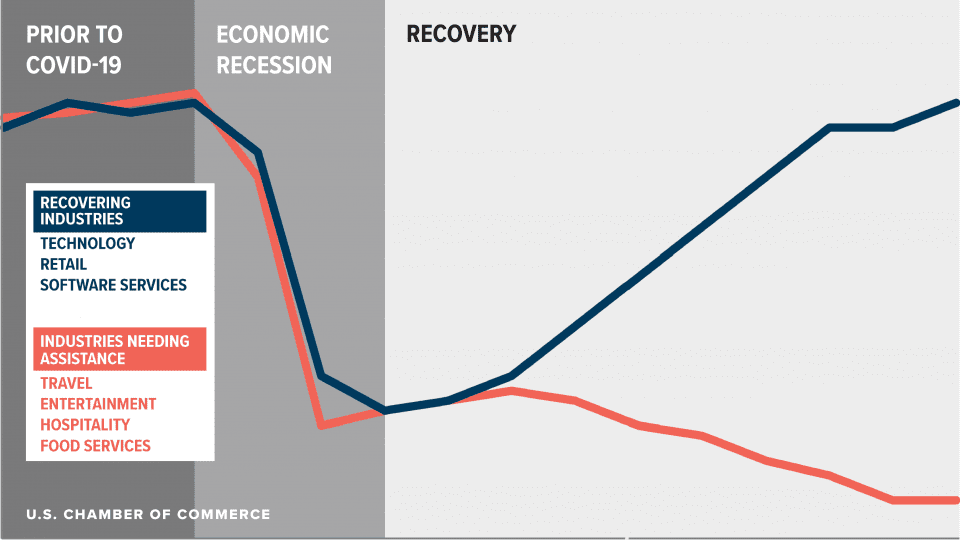
In her first testimony to the U.S. Senate Finance Committee, secretary of the treasury nominee Janet Yellen told legislators:
“Over the next few months, we are going to need more aid to distribute the vaccine; to reopen schools to help states keep firefighters and teachers on the job. We’ll need more funding to make sure unemployment insurance checks still go out, and to help families who are at risk of going hungry or losing the roof over their heads.
“Neither the president-elect nor I propose this relief package without an appreciation for the country’s debt burden, But right now … the smartest thing we can do is act big. In the long run, I believe the benefits will far outweigh the costs, especially if we care about helping people who have been struggling for a very long time.”
Yellen’s reference to acting “big” means a larger stimulus contribution to the U.S. economy to ensure consumers have cash to spend on their current needs in the pandemic, which would in theory boost the economy more immediately than a more “trickle down” approach from the top end of the K-curve.
Consider a 50/50 Congress
Yellen’s approach and rationale run counter to certain congressional legislators’ commitment to “austerity,” which is in opposition to the “go big” for stimulus spending that would increase the federal deficit.
The 50/50 split in the U.S. Congress is a challenge that the bold vision and $1.9 trillion spending plan the Biden administration has set out will have to navigate. Assuming all Democrats would support the $1.9 trillion plan, a vote for the act would need 10 Republicans to join with 50 Democrats to pass the legislation. That is, unless a reconciliation process kicks in, which, assuming a 50/50 split in votes, would/could be broken with the vote of Vice President Kamala Harris.
The phenomenon of Georgia’s two Senate seats going to Democrats Raphael Warnock and Jon Ossoff changed the math in Congress for healthcare legislation, whether the immediate COVID-19 response funding or more macro health reform (say, bolstering the Affordable Care Act or drug price negotiations for Medicare).
A Return to the Affordable Care Act
In the Biden stimulus plan supported by Yellen, there is a sentence addressing ACA subsidies for Americans seeking health insurance. This is important because enhancing subsidies for buying health insurance addresses the first “A” in the ACA: affordability.
If that provision stays in the plan after either Congressional budget reconciliation or stimulus plan negotiation, more people could sign up for health insurance on Healthcare.gov exchanges that have been eroded over the past four years.
“With good outreach and enrollment assistance, you could bring a good deal more people in” to the health insurance coverage rolls, according to Linda Blumberg, a fellow at the Health Policy Center at the Urban Institute. It wouldn’t get the U.S. to universal coverage, but Blumberg forecasts millions of additional newly covered health citizens.
Onward, Health Citizens, Through and Beyond COVID-19
In the week leading up to Biden’s inauguration—in a poll conducted following the attack on the nation’s Capitol and Congress’s rotunda—most voters supported expanding investment in addressing the pandemic, extending the ACA enrollment and restoring funds to market ACA plans.
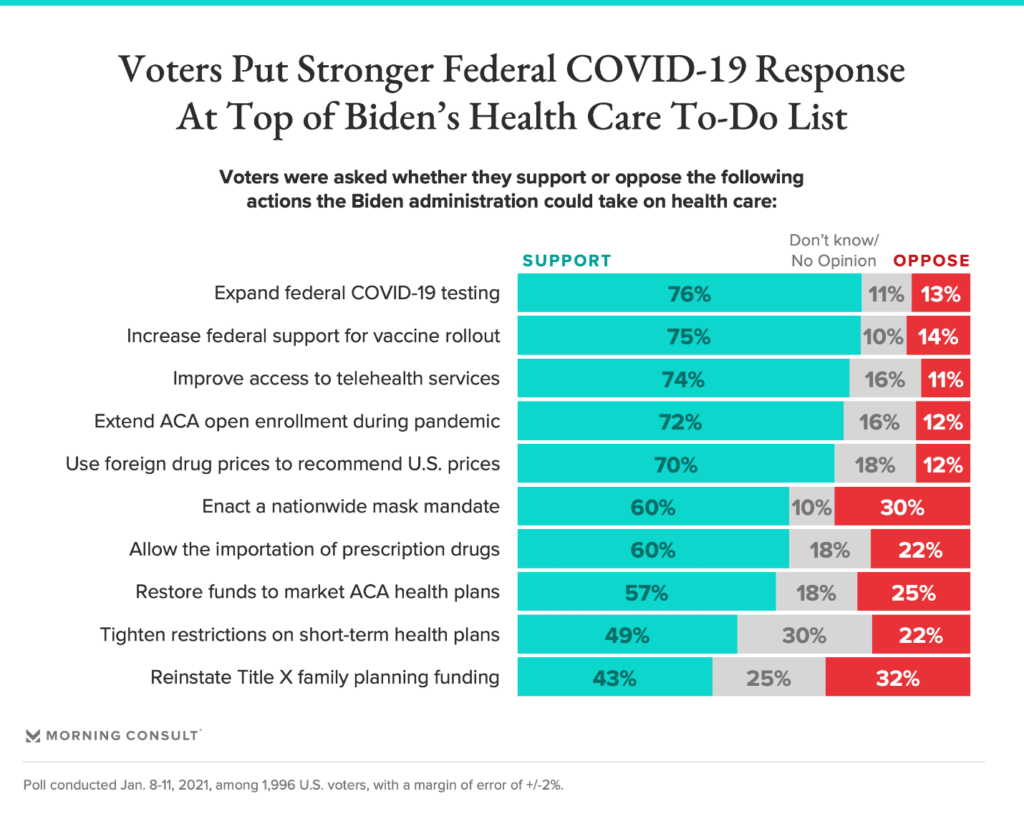
It’s also important to see most Americans supporting access to telehealth and virtual care, which they came to experience during the pandemic for their own healthcare.
Few U.S. presidents have taken their seat on Day 1 in the Oval Office with such a daunting docket of challenges: a virulent epidemic, a shattered economy with millions of job losses to recover, a wide social and political chasm splitting the country, and climate change fears looming on citizens’ minds.
This post touched on just the first 100 days of Biden’s healthcare agenda. There are several other major healthcare line items the Biden administration will try to address in and beyond 2021, including revisiting healthcare reform (a public option? lowering the Medicare age?), dealing with drug prices (which has some bipartisan support), supporting the use of telehealth and virtual care services, and dealing with the growing mental health burden, a next-normal for citizens and healthcare providers alike.
But first, the top priorities for the Biden administration: COVID-19, American lives and livelihoods, to set right the American ship. As on any ship … we are all on and in this together. Godspeed to all of us. Stay well, stay strong, stay loving.
Editor’s Note: Many Americans have put off routine medical care and tests during the pandemic. Get Jane’s take on the impact of deferred medical care and hear from Medecision’s clinical experts with facts about the COVID-19 vaccines.
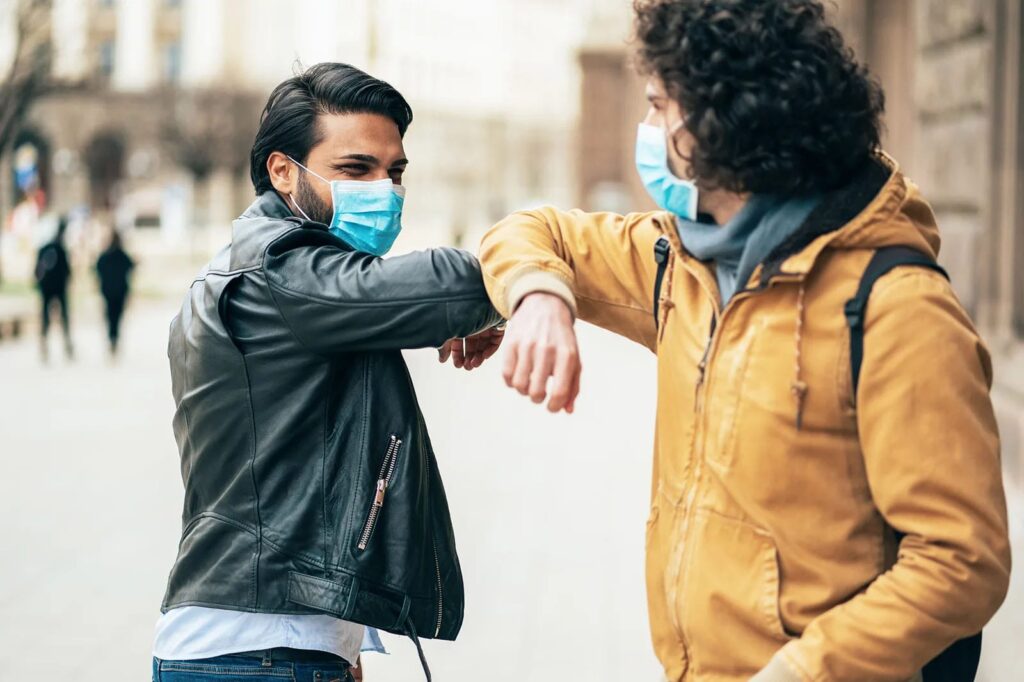

About The Author: Jane Sarasohn-Kahn, MA, MHSA
Through the lens of a health economist, Jane defines health broadly, working with organizations at the intersection of consumers, technology, health and healthcare. For over two decades, Jane has advised every industry that touches health including providers, payers, technology, pharmaceutical and life science, consumer goods, food, foundations and public sector.
More posts by Jane Sarasohn-Kahn, MA, MHSA